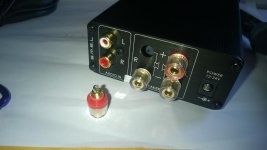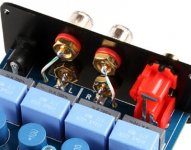Class D amplifiers generally have restricted HF performance, particularly wrt damping factor, and to a lesser extent, with distortion and frequency extension. After all, the rail to rail switching noise of the output stage must be massively filtered against with ****guh...guh...guh...gasp!?!**** passive "audio friendly composition core" inductors and capacitors, and they most always switch at a rate below 1Mhz, anyway. Also, hopefully the rest of the audio system is RFI 'friendly'.
Last edited:
I have a bunch of old stranded wire that I'll bet would change Gedlee's mind about "all wires tasting like water".
A lot of the strands are kinda funny colors because of the exposure to the atmosphere that affects almost all speaker wires. Might have to throw on some duct tape for a few sections where the rubber and plastic insulation flaked off, too.
A lot of the strands are kinda funny colors because of the exposure to the atmosphere that affects almost all speaker wires. Might have to throw on some duct tape for a few sections where the rubber and plastic insulation flaked off, too.
Last edited:
I have a bunch of old stranded wire that I'll bet would change Gedlee's mind about "all wires tasting like water".
A lot of the strands are kinda funny colors because of the exposure to the atmosphere that affects almost all speaker wires. Might have to throw on some duct tape for a few sections where the rubber and plastic insulation flaked off, too.
If coat hangers can't be A/B tested to sound different, I doubt oxidized copper would either.
Wow. Never seen this before. Coaxial with horn.
PreSonus | Sceptre
https://www.youtube.com/watch?v=nzE9NIm7zbE
Should give a nice Xover but what about diffraction? That looks like an issue to me. Of course; not much CD either with that small horn.
An externally hosted image should be here but it was not working when we last tested it.
PreSonus | Sceptre
https://www.youtube.com/watch?v=nzE9NIm7zbE
Should give a nice Xover but what about diffraction? That looks like an issue to me. Of course; not much CD either with that small horn.
Cool. Hadn't seen those before. JBL it is.How about the old UREI 813's?
An externally hosted image should be here but it was not working when we last tested it.
From a review of the Presonus Sceptre:
Besides the difficulty of manufacture, coaxial designs have problems of their own. It’s highly complex, but the issues include the woofer modulating the high frequencies, low-frequency diffraction around the tweeter horn, and reflections from the rear of the horn bouncing off the woofer and being propelled forward, out of sync with the direct sound.
Whereas previous solutions relied on analogue electronics and mechanical tweaks, modern coaxial monitor manufacturers such as PreSonus are utilising DSP technology. This entailed teaming up with Dave Gunness of Fulcrum Acoustic, and PreSonus licensed Fulcrum’s Temporal Equalisation (TQ) algorithms to “deal with the issues using multiple, fully addressable, fairly large Finite Impulse Response (FIR) filters to eliminate horn reflections and to correct linear time and amplitude anomalies”.
The ultra-rigid HF horn is shaped to keep sound energy away from the woofer cone, and rather than attempting to polish the proverbial, the hardware and DSP processing were actually designed to work together from the start. TQ employs highpass, lowpass and parametric filters alongside delay.
We would need to see an impulse response if there's diffraction issues or not.
Cool. Hadn't seen those before.
Those are pretty classic speakers. Hugely popular decades ago. They were not originally JBL, they were UREI. They were referenced in my foam patent as prior art.
licensed Fulcrum’s Temporal Equalisation (TQ) algorithms to “deal with the issues using multiple, fully addressable, fairly large Finite Impulse Response (FIR) filters to eliminate horn reflections and to correct linear time and amplitude anomalies
But they neglect to point out that this cannot be a global correction as it will only work correctly at a single point in space. All other points get worse.
We would need to see an impulse response if there's diffraction issues or not.
At more than one point in space.
Last edited:
Wow. Never seen this before. Coaxial with horn.
An externally hosted image should be here but it was not working when we last tested it.
Should give a nice Xover but what about diffraction? That looks like an issue to me. Of course; not much CD either with that small horn.
Those look like a newer version of some Altec 605s I once had a chance to compare to my Tannoy System 12 DMT IIs. Suffice it to say that the Altecs didn't wow me on their own, and suffered greatly from direct comparison.
Hiraga did more than a decent speaker with the ALTEC coaxial some years ago...
The Urei was expensive iirc... but punchy ! Not so bad monitors... a dream when I was younger !
The Urei was expensive iirc... but punchy ! Not so bad monitors... a dream when I was younger !
Remember that cheap class D amp that was recommended and I bought for $50 from China?
Well, I got it several days ago. When I tried to unscrew the speaker terminals, one was stuck. I used a little force on it and the terminal loosened! And there are loose parts inside the amp now. Great quality!
And do you think Shenzhenaudio has answered my e-mail? Nope, of course not. Looks I've bought myself a DIY amp. 🙄
Well, I got it several days ago. When I tried to unscrew the speaker terminals, one was stuck. I used a little force on it and the terminal loosened! And there are loose parts inside the amp now. Great quality!
And do you think Shenzhenaudio has answered my e-mail? Nope, of course not. Looks I've bought myself a DIY amp. 🙄
Attachments
Of course. How stupid of me. 😀You are supposed to buy three or more and pick out the two that actually work.
Chinese quality and service!
It's the most sensitive spectra of human hearing BUT most designers appear to choose it for their mid-high pass. Why is this?
Cos' we always dunnit this way !
Of course. How stupid of me. 😀
Chinese quality and service!
So, let's summarize what you were given for 50$.
- fully assembled TPA3118D2 digital amp
- power supply
- free shipping
The nut is airborne. Tricky issue to deal with.
Attachments
For 50 bucks there is not much to complain, I believe. So I've ordered one myself. If it is good, it will replace the AB amp driving my mid-highs panels. Load invariance would not be such a big issue as a dedicated amp.
Heck it might even be small enough to integrate it in the same enclosure with my DAC/DSP/ASP unit, I kind of grew tired of big components lying in a rack.
Heck it might even be small enough to integrate it in the same enclosure with my DAC/DSP/ASP unit, I kind of grew tired of big components lying in a rack.
Something like this: http://www.diyaudio.com/forums/minidsp/194010-minidsp-based-system-gallery.html
I am trying to make something similar too.
I am trying to make something similar too.
Amp has arrived and had EXACTLY the same issue as in the picture above. I've opened it (yes, guarantee is void, but who cares..) and screwed the nut properly. What bothered me even more is the obvious bad soldering (the speaker output wire unsoldered !). Other than that, the board itself looks very good.
The sound is really good, did not notice any anomaly and it rendered the sound I am used to from my speakers, with a rich soundstage on proper recordings. Voices are very clean and cymbals "ethereal" 🙂 The thingie is REALLY small, smaller than it looks in the pictures. Integrating in the main case of the DSP/ASP is possible.
The sound is really good, did not notice any anomaly and it rendered the sound I am used to from my speakers, with a rich soundstage on proper recordings. Voices are very clean and cymbals "ethereal" 🙂 The thingie is REALLY small, smaller than it looks in the pictures. Integrating in the main case of the DSP/ASP is possible.
Wrt speakers with xovers between 1&4 khz, how about the JBL 515 265F-1 15" woofer which crosses over to the 2414H tweeter at 2.2Khz?
The 265F-1 cone profile appears to be curvilinear, like that of the 2220 series, so that may be how JBL has kept away from major dispersion issues above 700 hz with this design. IAC, I haven't read anything where anything bad was written about the mids in this design.
I wonder if anybody has gotten a good listening impression of JBL's Differential Drive approach in general, also?
The 2414H tweeter appears quite small (2 3/8 " diameter & about 3/4" thick) to be rated at 100Wrms, btw. If anybody has a tech spec sheet for the tweeter, I'd like to see it since I am considering it for a smaller speaker project.
The 265F-1 cone profile appears to be curvilinear, like that of the 2220 series, so that may be how JBL has kept away from major dispersion issues above 700 hz with this design. IAC, I haven't read anything where anything bad was written about the mids in this design.
I wonder if anybody has gotten a good listening impression of JBL's Differential Drive approach in general, also?
The 2414H tweeter appears quite small (2 3/8 " diameter & about 3/4" thick) to be rated at 100Wrms, btw. If anybody has a tech spec sheet for the tweeter, I'd like to see it since I am considering it for a smaller speaker project.
Last edited:
- Status
- Not open for further replies.
- Home
- Loudspeakers
- Multi-Way
- Why crossover in the 1-4khz range?

